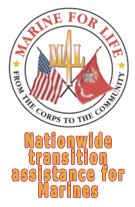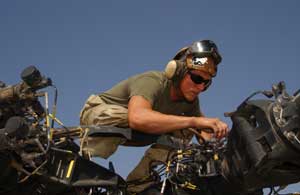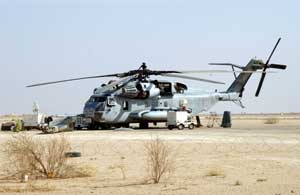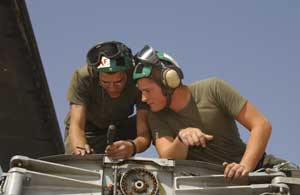|
|
| Marine For Life Info |
|

|
|

|

HMH-361 phase maintenance crew keeps ‘Stallions’ airborne
Submitted by: 3rd Marine Aircraft Wing
Story Identification #: 20041012171039
Story by Cpl. Paul Leicht

AL ASAD, Iraq (Oct. 4, 2004) -- Service in Iraq has demanded a high operational tempo from Marine helicopter squadrons supporting troops on the ground.
Around the clock in the Iraqi desert, CH-53E Super Stallions with Marine Heavy Helicopter Squadron 361, Marine Aircraft Group 16, 3rd Marine Aircraft Wing, here are being flown to their mechanical limits. After many flight hours in such harsh conditions, even the mighty CH-53E needs new parts and a periodic overhaul.
To keep their aircraft in top condition, the “Flying Tigers” have a small, tight-knit group of enlisted Marines whose sole purpose is to bring their squadron’s helicopters back to life with preventative maintenance.
They are called the phase maintenance crew and their job is to virtually dismantle combat aircraft to perform necessary maintenance.
“Like cars, our helicopters need phase or regular maintenance to avoid any problems and to help minimize breakdowns during operations,” said Sgt. Steve E. Hickok, airframes technician, HMH-361, and a native of Salt Lake City. “To do this we need to completely break them down.”
Each of the squadron’s CH-53Es is sent for regular phase maintenance after every 150 flight hours, according to Staff Sgt. Stuart M. Clark, phase noncommissioned officer-in-charge, HMH-361.
Without phase inspections, aircraft would likely break more often, would not be able to fly as many flight hours and it would take longer to make several repairs on the flight line instead of one big project, said Clark.
“So far, we have done eight phase inspections in the past 43 days,” said the 29-year-old Kalamazoo, Mich., native. “Back at (Marine Corps Air Station, Miramar, Calif.) we normally do two a month and see an aircraft maybe once a year. We have four times the workload and have doubled our efforts (in Iraq). We have a constant drive and never let up.”
After a CH-53E moves through the progression of maintenance, the phase maintenance crew first begins to strip away the aircraft’s ‘skin’ to expose the hydraulic lines and the flight control systems.
“We remove the exterior panels and go as deep into the guts of the aircraft as we can to in order to do our inspection and fix whatever is necessary,” said 22-year-old Lance Cpl. Michael P. Taylor, flight line technician, HMH-361, and a native of Marlton, N.J.
With more than 90 points of inspection, phase maintenance is critical to keeping the CH-53Es in the fight.
“Unlike at Miramar, we are very much highlighted out here because the squadron relies on us to save the aircraft from the affects of the desert,” said 29-year-old Sgt. Kwaku Amoako-Atta, avionics technician, HMH-361.
Clark added that his section, composed of sixteen Marines and two civilian mechanics, working day and night in two overlapping shifts, can take an aircraft apart, fix whatever is broken, put it back together and clean it in as little as four to six days.
“Sometimes it can take longer if we are doing heavy maintenance or working on ‘high time’ components like the transmissions, servo motors, rotors, drive trains, drive shafts or gear boxes,” explained Clark. “Parts just reach the end of their life span out here a lot sooner and have to be either repaired or replaced.
“We also replace certain parts that the manufacturer recommends replacing at certain intervals,” he added. “We do a lot in phase, but we can’t do it all because there are some parts and systems that we are not supposed to touch that normally get taken care of back (in garrison).”
Clark said his shop has accomplished their mission if an aircraft flies with no maintenance issues until its next phase inspection, and so far that is how it has been.
“Our phase crew Marines have really been working their butts off out here,” said Gunnery Sgt. Michael A. Keatley, airframes chief, HMH-361. “They are as good as it gets. Without them our squadron’s helicopters would not fly.”
-30- |

Photos included with story: | Lance Cpl. Michael P. Taylor, flight line technician, Marine Heavy Helicopter Squadron 361, Marine Aircraft Group 16, 3rd Marine Aircraft Wing, inspects the sleeve and spindle drain screws on a CH-53E Super Stallion during a phase inspection on the flight line at Al Asad, Iraq, Oct. 4. The 22-year-old Marlton, N.J., native is one of the squadron's sixteen phase maintenance Marines that virtually disassemble the aircraft to perform preventative maintenance every 150 flight hours. Photo by: Cpl. Paul Leicht | |
|
 | Sgt. Kwaku Amoako-Atta, avionics technician, Marine Heavy Helicopter Squadron 361, Marine Aircraft Group 16, 3rd Marine Aircraft Wing, inspects one of the squadron's CH-53E Super Stallions during a phase maintenance inspection on the flight line at Al Asad, Iraq, Oct. 4. The 29-year-old Atlanta native is one of the squadron's sixteen phase maintenance Marines that virtually disassemble the aircraft to perform preventative maintenance every 150 flight hours. Photo by: Cpl. Paul Leicht | |
|
 | Lance Cpl. Miguel Ramos, avionics technician, Marine Heavy Helicopter Squadron 361, Marine Aircraft Group 16, 3rd Marine Aircraft Wing, grinds a chip detector on one of the squadron's CH-53E Super Stallions during a phase maintenance inspection on the flight line at Al Asad, Iraq, Oct. 4. The 20-year-old Fontana, Calif., native is one of the squadron's sixteen phase maintenance Marines that virtually disassemble the aircraft to perform preventative maintenance every 150 flight hours. Photo by: Cpl. Paul Leicht | |
|
 | A CH-53E Super Stallion with Marine Heavy Helicopter Squadron 361, Marine Aircraft Group 16, 3rd Marine Aircraft Wing, goes through phase maintenance on the flight line at Al Asad, Iraq, Oct. 6. Photo by: Cpl. Paul Leicht | |
|
 | Lance Cpls. John P. Wills (left), a 26-year-old West Virginia native and Wade Sellers, a 19-year-old native of Virginia, airframes technicians, Marine Heavy Helicopter Squadron 361, Marine Aircraft Group 16, 3rd Marine Aircraft Wing, remove a panel on the tail of a CH-53E Super Stallion during a phase maintenance inspection on the flight line at Al Asad, Iraq, Oct. 4. Wills and Sellers are two of the squadron's sixteen phase maintenance Marines that disassemble the aircraft to perform preventative maintenance every 150 flight hours. Photo by: Cpl. Paul Leicht | |
|
|

